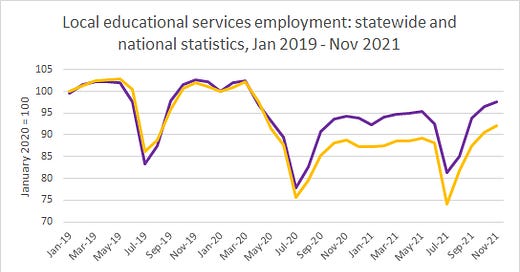Back before the holiday break in the newsletter, I wrote that while regional employment growth is strong, some parts of the economy have not recovered from the drop they experienced at the start of the pandemic: the public, financial activities, and manufacturing sectors. The biggest of these is the public sector, which employs about 15.5% of all nonfarm employment in the region, and within that, a very specific but important subsector is seeing the greatest decline: K-12 public schools, employing about 7.3%, or a little over 100,000 workers, of the region’s nonfarm workforce.
A student followed up with me after that post (hi Angel M.! THANK YOU!) asking whether this is a common trend in other parts of the state and country, and just wondering more about it in general. That’s what this article is about.
First, the decline in education-related employment is also occurring in the private sector. Both private and public sector educational services employment is down about 10% from pre-pandemic times. But since the public educational sector is much bigger (by a factor of about 4 out here in the IE), it’s more pronounced in the statistics.
Second, the decline is happening both statewide and nationally, though to smaller degrees nationally. To show this, below I’ve presented indexes of the public educational employment statistics for California and the nation – they don’t show you the level of employment, but they do allow you to judge where employment is today relative to some point in the past. By the way, as you can tell from these numbers, there is some seasonality to educational services employment that’s just part of the industry. The way to interpret these statistics is as follows: during the 2020-2021 academic year, nationally, schools were operating at about 5% (index around 95) less than pre-pandemic times, whereas in California, schools were operating at about 12% (index around 88) less than pre-pandemic times. This academic year (2021-2022), that has improved to 3% nationally and 8% in California, but that is still a significant drop from pre-pandemic times.
Third, one follow up question is, “why?”. Why have our schools been shedding workers? For example, we know that schools received a lot of federal COVID-related relief aid – in fact, about $120 billion in total nationally, which translates to hundreds of millions of dollars for some of the biggest school districts. Why hasn’t that money been used to invest in the schools and expand employment?
It turns out that many school districts have only spent a fraction of the money they received in COVID-related relief from the federal government. There are some horror stories of the money being used on sports stadiums instead of instruction-related projects, but I don’t know how widespread such stories are. At the very least, the aid is being collected but not spent out to a great degree. Here are some statistics for local school districts, collected from this article:
Here are some breakdowns of how the money has been spent by major spending area, again from the article linked above. For example, of the money that Fontana Unified has spent (which, again, is only 37% of its total, or about $72 million), 39.3% of it went to devices and other technology and 35.4% went to learning support:
It’s unclear where money for a new sports program might fall within these categories, but in their defense, school districts are probably still very uncertain about what the future will bring, so they might be holding onto some money for that reason. It’s also possible that they have not received all of the money that has been promised to them. These possibilities aside, it is most likely that an underutilization of this grant money is one of the reasons why school employment has not expanded at a fast enough pace over the last year or so (see here for more commentary on this issue). The public sector employment crisis, in other words, is partly of the schools’ own doing.





